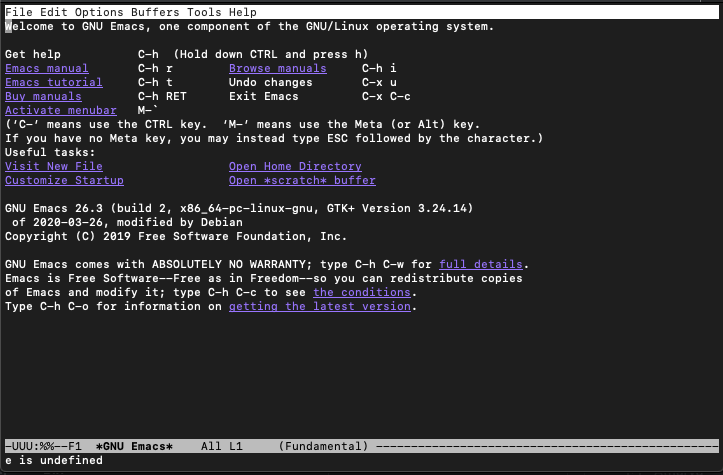


Next, it can again prompt you for the confirmation enter yes or no and then press return key. Or when you press C-x and then C-c this will prompt you to save or discard saving the content of the file.Īs prompted in the last line in the blue text, press y to save, n to discard, or q for quitting from the editor. To save a file press C-x and then C-s (Ctrl+x and then Ctrl+s). Alt+k Save file & exit from the editorĪfter creating or modifying a document in the editor you would want to save the modification and exit from the editor.
X86 emacs tutorial full#
Rather than using the full name, we will use them in the short form for example – The emacs command generally uses control key (Ctrl or CTL) and meta keys (labeled as Alt or Edit) with some other keys. So here we will discuss some basic commands used in emacs. While working in text mode you may need to use command for working efficiently. Or use the following command if you want to open a file – emacs -nw testfileĮmacs also uses the different combination of keys and commands for creating and editing or navigating into a file, Unlike vi text editor you need not switch between different modes. To open emacs in text mode use -nw (no window) option with emacs command in the terminal. It provides a menu you can navigate among them to perform a task. Working in GUI mode is very similar to working with other text editors. If the testfile exists in the system the emacs window will open with its content otherwise it will start with an empty editing buffer and waits for you to start typing. Or if you want to open a file using emacs then use – emacs testfile Launch emacs in GUI modeĮmacs will by default launch in GUI mode if you use the following command – emacs In GUI mode a separate emacs window will open while in text mode editor opens inside the terminal. You can start editing in the emacs text editor in two modes GUI and command line or text mode.
X86 emacs tutorial how to#
Use the following command to install emacs on RHEL/CentOS/Fedora – sudo yum install emacsĪfter the installation, you can verify it by using – emacs -version How to start Emacs text editor If you are using an rpm-based Linux distribution then you can use the given command to install emacs on it.
X86 emacs tutorial update#
I encourage you to open Emacs and press ctrl-h r to open the built-in manual and ctrl-h t to open the official tutorial.First, update the OS package repository by using – sudo apt update More than I am able to write in this little introduction. Or ctrl-x followed by c (keep ctrl pressed). You can exit Emacs pressing ctrl-x followed by ctrl-c. You confirm the folder:Īnd Emacs tell you the file exists, asking you if it should overwrite it:Īnswer y, and you get a confirmation of success: You can start editing and once you are done, press ctrl-x followed by ctrl-w. You can also edit an existing file calling emacs : To fix this, run brew install emacs and running emacs will use the new version from Homebrew (make sure you have Homebrew installed) This is not a problem with Vim, which is up to date.

While there is a little problem with the commands I listed up to now, in this case using an emacs version from 2007 is not exactly the same as using a version with 12 years of improvements and change. If you are on Linux there are no problems, but macOS does not ship applications using GPLv3, and every built-in UNIX command that has been updated to GPLv3 has not been updated. You can open a new emacs session simply by invoking emacs: Some people use it all day long as a kind of operating system ( ). Famously vi vs emacs flame wars and heated discussions caused many unproductive hours for developers around the world.Įmacs is very powerful. Emacs is an awesome editor and it’s historically regarded as the editor for UNIX systems.


 0 kommentar(er)
0 kommentar(er)
